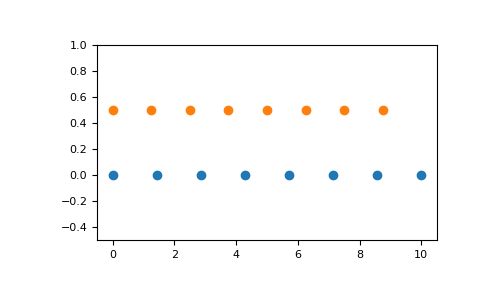numpy.linspace使用详解
2017-07-22 11:39
691 查看
numpy.linspace(start, stop, num=50, endpoint=True, retstep=False, dtype=None)
在指定的间隔内返回均匀间隔的数字。
返回num均匀分布的样本,在[start, stop]。
这个区间的端点可以任意的被排除在外。
See also
arangeSimilar to linspace, but uses a step size (instead of the number of samples).arange使用的是步长,而不是样本的数量 logspaceSamples uniformly distributed in log space.
当endpoint被设置为False的时候
>>> import numpy as np
>>> np.linspace(1, 10, 10)
array([ 1., 2., 3., 4., 5., 6., 7., 8., 9., 10.])
>>> np.linspace(1, 10, 10, endpoint = False)
array([ 1. , 1.9, 2.8, 3.7, 4.6, 5.5, 6.4, 7.3, 8.2, 9.1])
In [4]: np.linspace(1, 10, 10, endpoint = False, retstep= True)
Out[4]: (array([ 1. , 1.9, 2.8, 3.7, 4.6, 5.5, 6.4, 7.3, 8.2, 9.1]), 0.9)
官网的例子
Examples
>>>
Graphical illustration:
>>>

在指定的间隔内返回均匀间隔的数字。
返回num均匀分布的样本,在[start, stop]。
这个区间的端点可以任意的被排除在外。
| Parameters(参数): | start : scalar(标量) The starting value of the sequence(序列的起始点). stop : scalar 序列的结束点,除非endpoint被设置为False,在这种情况下, the sequence consists of all but the last of num + 1 evenly spaced samples(该序列包括所有除了最后的num+1上均匀分布的样本(感觉这样翻译有点坑)), 以致于stop被排除.当endpoint is False的时候注意步长的大小(下面有例子). num : int, optional(可选) 生成的样本数,默认是50。必须是非负。 endpoint : bool, optional 如果是真,则一定包括stop,如果为False,一定不会有stop retstep : bool, optional If True, return (samples, step), where step is the spacing between samples.(看例子) dtype : dtype, optional The type of the output array. If dtype is not given, infer the data type from the other input arguments(推断这个输入用例从其他的输入中). New in version 1.9.0. |
|---|---|
| Returns: | samples : ndarray There are num equally spaced samples in the closed interval [start, stop] or the half-open interval [start, stop) (depending on whether endpoint is True or False). step : float(只有当retstep设置为真的时候才会存在) Only returned if retstep is True Size of spacing between samples. |
arangeSimilar to linspace, but uses a step size (instead of the number of samples).arange使用的是步长,而不是样本的数量 logspaceSamples uniformly distributed in log space.
当endpoint被设置为False的时候
>>> import numpy as np
>>> np.linspace(1, 10, 10)
array([ 1., 2., 3., 4., 5., 6., 7., 8., 9., 10.])
>>> np.linspace(1, 10, 10, endpoint = False)
array([ 1. , 1.9, 2.8, 3.7, 4.6, 5.5, 6.4, 7.3, 8.2, 9.1])
In [4]: np.linspace(1, 10, 10, endpoint = False, retstep= True)
Out[4]: (array([ 1. , 1.9, 2.8, 3.7, 4.6, 5.5, 6.4, 7.3, 8.2, 9.1]), 0.9)
官网的例子
Examples
>>>
>>> np.linspace(2.0, 3.0, num=5) array([ 2. , 2.25, 2.5 , 2.75, 3. ]) >>> np.linspace(2.0, 3.0, num=5, endpoint=False) array([ 2. , 2.2, 2.4, 2.6, 2.8]) >>> np.linspace(2.0, 3.0, num=5, retstep=True) (array([ 2. , 2.25, 2.5 , 2.75, 3. ]), 0.25)
Graphical illustration:
>>>
>>> import matplotlib.pyplot as plt >>> N = 8 >>> y = np.zeros(N) >>> x1 = np.linspace(0, 10, N, endpoint=True) >>> x2 = np.linspace(0, 10, N, endpoint=False) >>> plt.plot(x1, y, 'o') [<matplotlib.lines.Line2D object at 0x...>] >>> plt.plot(x2, y + 0.5, 'o') [<matplotlib.lines.Line2D object at 0x...>] >>> plt.ylim([-0.5, 1]) (-0.5, 1) >>> plt.show()

相关文章推荐
- numpy.linspace使用详解...
- numpy.linspace使用详解
- numpy.linspace使用详解
- 均分函数 numpy.arange() 和 numpy.linspace()
- 对python numpy数组中冒号的使用方法详解
- numpy.random.rand使用详解
- numpy.linspace介绍
- numpy.linspace 生成等差数组的方法
- 对numpy中的where方法嵌套使用详解
- numpy.linspace()
- numpy的linspace使用详解
- Android Widgets 之 Space 使用详解
- numpy.linspace 生成等差数组
- numpy.linspace()等差数列函数
- Numpy 使用详解
- numpy.random.rand使用详解
- numpy——linspace创建等差数列
- Window 消息大全使用详解
- Ghost 使用详解
- 使用SPEncode.HtmlEncodePreserverSpace保存输入
